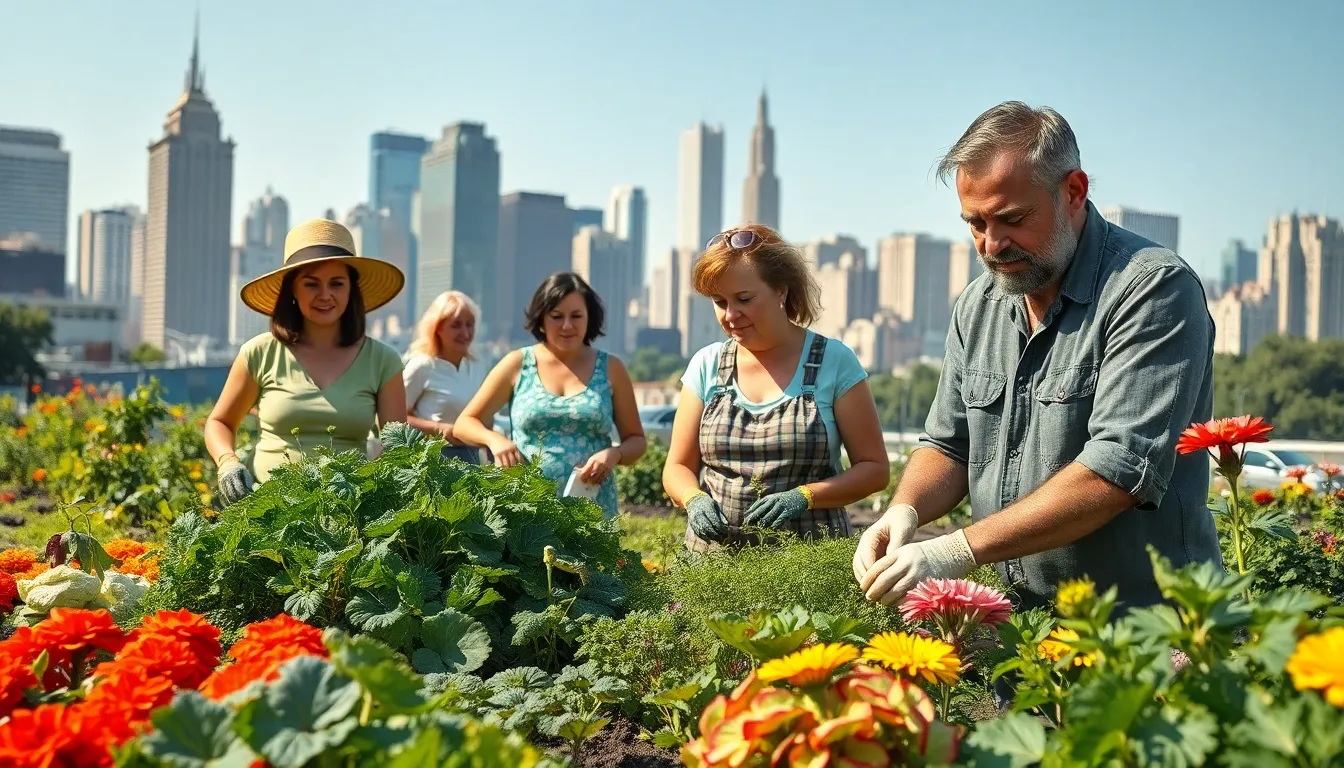In a world where concrete jungles reign supreme, a green revolution is quietly sprouting up in urban backyards, rooftops, and even balconies. Urban farming is no longer just a niche hobby for hipsters; it’s becoming a lifestyle choice for city dwellers eager to reconnect with their food sources. Who knew that growing tomatoes could be the ultimate act of rebellion against bland supermarket produce?
Table of Contents
ToggleOverview of Urban Farming Trends
Urban farming has transformed into a notable practice among city dwellers. City residents increasingly cultivate gardens on rooftops, balconies, and vacant lots. They prioritize fresh produce over store-bought options, which often lack flavor and nutritional value. Community gardens, where multiple individuals can participate, foster social connections and engagement.
Sustainable techniques guide the movement, with many urban farmers adopting practices such as composting and permaculture. These methods enhance soil health and reduce waste. Numerous studies indicate that urban farming can help reduce carbon footprints by shortening food transportation distances.
Technological advancements also play a key role in this trend. Hydroponics and aquaponics systems allow individuals to grow food in limited spaces using minimal resources. Integration of smart technology, including sensors and apps, provides real-time monitoring of plant health, optimizing growth conditions.
Local governments support urban farming initiatives through grants and policy changes. These efforts focus on improving access to fresh produce in food deserts, which are areas with limited grocery store access. Based on recent surveys, approximately 25% of urban farmers engage in business activities, further contributing to local economies.
The urban farming trend encapsulates a shift toward self-sufficiency, sustainability, and community involvement. As more city residents embrace this lifestyle, they reconnect with their food sources and cultivate healthier environments.
Benefits of Urban Farming

Urban farming offers numerous advantages, enhancing both personal and community well-being. It plays a crucial role in fostering a healthier environment and creating economic opportunities.
Environmental Impact
Urban farming significantly reduces carbon footprints as food travels shorter distances. It optimizes land use by transforming underutilized spaces, such as rooftops and vacant lots, into productive gardens. Techniques like composting improve soil health while recycling organic waste. Water conservation methods, including rainwater harvesting and drip irrigation, minimize resource usage. Sustainable practices contribute to biodiversity by creating habitats for pollinators and other wildlife.
Economic Advantages
Urban farming boosts local economies by creating job opportunities. Approximately 25% of urban farmers generate income through sales of fresh produce. Community gardens enhance neighborhood value, increasing property prices and attracting businesses. Local food production reduces dependence on long supply chains, fostering resilience in urban areas. Government support, in the form of grants, facilitates startup costs for new farmers, encouraging entrepreneurship. This trend allows city residents to invest in their communities while promoting healthy eating habits.
Popular Urban Farming Techniques
Urban farming incorporates various innovative methods that cater to the needs of city dwellers. This adaptability allows residents to maximize limited space while ensuring access to fresh produce.
Vertical Farming
Vertical farming utilizes multiple stacked layers to cultivate crops efficiently. This technique promotes greater yield per square foot, appealing to urban farmers with limited land. Indoor environments reduce pests and optimize climate control, creating ideal conditions for growth. Regularly, vertical farms implement advanced LED lighting, accelerating plant growth. Studies reveal that vertical farming can produce up to 20 times more food than traditional farming methods. Urban areas benefit from reduced transportation costs while providing locally sourced options. Integrating this approach enhances food security and encourages urban populations to actively participate in food production.
Hydroponics and Aquaponics
Hydroponics involves growing plants in nutrient-rich water instead of soil. This method conserves water and space, making it ideal for urban settings. By eliminating the need for traditional agriculture, urban farmers can grow healthier plants in smaller areas. Aquaponics combines hydroponics with aquaculture, using fish waste to nourish plants. This symbiotic relationship creates a self-sustaining ecosystem, producing both fish and vegetables simultaneously. Urban farmers engaging in these systems often realize faster growth rates and higher yields. Data shows that hydroponic systems can use up to 90% less water than conventional farming. Utilizing these innovative techniques enhances sustainability while transforming urban landscapes into productive green spaces.
Challenges Facing Urban Farmers
Urban farmers encounter numerous challenges that impact their ability to thrive in cities. Two prominent issues include space limitations and regulatory concerns.
Space Limitations
Space constraints significantly affect urban farming initiatives. Individuals often struggle to find suitable areas for planting, especially in densely populated regions. Rooftops, balconies, and small yards provide limited options for crop cultivation. Community gardens may alleviate some issues, but they require cooperative participation and management. Many urban farmers rely on vertical farming systems to maximize small areas, allowing them to cultivate more produce. Despite these innovative solutions, the lack of available land remains a persistent challenge.
Regulatory Issues
Regulatory obstacles frequently hinder urban farming activities. Local zoning laws often restrict agricultural practices in urban areas, creating barriers for aspiring farmers. Permits may be necessary for certain installations, such as greenhouses or compost facilities, complicating the farming process. Many urban farmers face water usage restrictions that limit irrigation options. Efforts to advocate for supportive policies and streamlined regulations are essential for fostering urban agriculture growth. Local governments can improve this situation by introducing reforms that encourage urban farming and simplify compliance processes.
Future of Urban Farming Trends
Urban farming’s future leans heavily on technological advancements and enhanced community participation. Innovations in farming techniques will shape how food is cultivated in cities.
Technological Innovations
Technologies revolutionize urban farming. Hydroponics and aquaponics allow for efficient food production in confined spaces. These systems use minimal resources while maximizing yields. Smart technologies, including sensors and mobile applications, enable consistent monitoring of plant health. Real-time data optimizes growth conditions, decreasing water usage and enhancing crop quality. By 2025, the global vertical farming market is projected to reach over $12 billion, reflecting the growing interest in sustainable city agriculture. Moreover, automated systems reduce labor demands, simplifying operations for urban farmers.
Community Involvement
Community participation plays a vital role in urban farming’s success. Local residents engage in community gardens, fostering social bonds and cooperative efforts. Such initiatives improve neighborhood cohesion and encourage individuals to take part in food production. Approximately 60% of urban farming projects depend on community volunteers for maintenance and support. Local organizations often advocate for urban farming, pushing for policy changes that ease regulations. Workshops and educational programs help participants learn best practices and sustainable techniques. Increased involvement strengthens community ties and promotes a culture of healthy eating.
Urban farming is reshaping the way city dwellers interact with their food and environment. This movement not only promotes self-sufficiency but also fosters community engagement and sustainability. As more individuals embrace innovative techniques and smart technologies, urban spaces are transforming into vibrant green landscapes.
The benefits extend beyond personal health to include economic opportunities and environmental advantages. With ongoing support from local governments and communities, urban farming is poised to thrive. Its impact on food security and community well-being is undeniable, paving the way for a healthier and more connected urban future.



